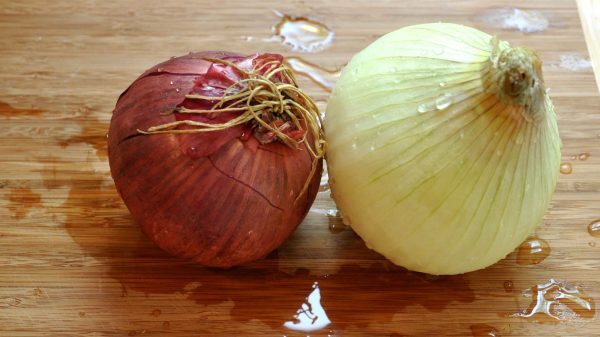Onion

Allium cepa
One of the oldest crops in human history, gardeners grow these members of the lily family for the immature green bunching onions, often called scallions, or for the mature dry bulbs. Onions seem to have originated in the eastern Mediterranean from Palestine to India.
• More detailed information can be found in The Georgia Fruit & Vegetable Book by Walter Reeves and Felder Rushing
• See also:
The Old Testament describes them as one of the items the Israelites longed for during their long sojourn in the desert. Onions are so easy to grow and so useful in the kitchen that they should be part of every garden.
WHEN TO PLANT
Onions are completely hardy; put them out as soon as the soil can be worked in mid- to late- winter. Start them from seed sown directly in the garden, from seedling transplants (called stick-outs), or from onion sets (sets are most often available commercially). Sets which are tiny onion bulbs grown the previous season are the easiest way to start onions in the home garden, especially in the late winter. Sow seed for stick-outs indoors under lights about mid-January.
WHERE TO PLANT
Plant onions in full sun (8 to 10 hours will suffice) in well-prepared, well-drained soil. (See “Soil Preparation” in the introduction to the vegetable garden.)
HOW TO PLANT
Apply a complete garden fertilizer, such as 10-10-10, at a rate of 11/2 pounds per 100 square feet of garden. Work the soil until it is finely broken up. In rows, space stick-outs 3 inches apart, with 12 to 15 inches between rows. In beds, space the plants 3 inches apart in rows 12 inches apart across the beds, which will allow 12 to 15 plants across the beds. Set the plants somewhat deeper than they were growing, about 1 inch. Water in the plants with a transplant starter fertilizer, such as 10-52-17 or 10-30-10, mixed according to directions on the label. If onion maggots have been a problem in the past and your previous crops have been damaged, mix an approved garden insecticide in water according to the label directions, and use it as a drench as transplants are watered in. Space onion sets 1 inch apart for green onions and 3 inches apart for dry onions. For dry onions, push the sets into the soil surface. For green onions, plant the sets 2 or 3 inches deep to develop the long, white stems. Direct seed 12 to 15 seeds per foot of row, and thin to the proper spacing when they are about 4 inches tall. Thin to 1 per inch for green bunching onions, and eventually to 1 every 3 inches for dry onions. Use the green onions as you remove them for thinning.
CARE AND MAINTENANCE
Onions are shallowly rooted, so be careful as you hoe or pull weeds. Try to get as much top growth as possible by the first day of summer. Bulbs begin to form when the days reach about 15 hours in length, and the size of the dry onions is determined by the size of the tops. Apply 1 inch of water each week if the weather is dry. Side-dress onions with 10-10-10 fertilizer when the plants are about 12 inches tall.
ADDITIONAL INFORMATION
Harvest green onions when the stems are pencil-sized. Pull any dry onions that form flower stalks, and use them immediately because they will not store well as dry onions. When the tops begin to yellow and fall over, pull them to one side with the back of a rake. Do not walk the tops down or the development of the bulbs will stop. (walking the tops down refers to an old-fashioned idea that you needed to crush the tops to get the bulbs to form.) Pull the dry onions when all the tops have gone down, preferably in the morning during dry weather. Let them dry there in the garden where you pulled them until afternoon, then collect them and spread them on screens or slats so that they can cure for 2 to 3 weeks. After they are cured, knock off as much soil as possible, and cut the dry tops to about 11/2 inches long. Do not peel the bulbs, and do not wash them. Use damaged onions immediately. Store the onions in mesh bags or wire baskets in a dry, cool place, and they will last all winter.
VARIETIES
Some onions form bulbs when days are short, others when days are long. Short-day varieties such as the Vidalia onions grown in Georgia are grown in the winter in the. Unlike long-day varieties, which are better suited for planting in northern and midwestern states, short-day varieties will not form bulbs in the long days of summers, and they don’t store as long because of higher moisture content. Home gardeners have little choice when buying onion sets; use the varieties that are the easiest to obtain locally.
Varieties
Days to Maturity
Comments
Long Day Types:
Sweet Spanish
Sweet
Walla Walla
Sweet Mild
Yellow Globe Danvers
Globe.
Red Baron
Colorful in salads
Southport White Globe
Good slicer
Ebenezer
Slightly flat
Stuttgarter
Popular
Short Day Types:
Crystal White Wax
Flat, mild
Yellow Granex
Deep flat, sweet
Red Creole
Hard, small bulbs, pungent
Texas 1015
Very sweet
Vidalia
Sweet












